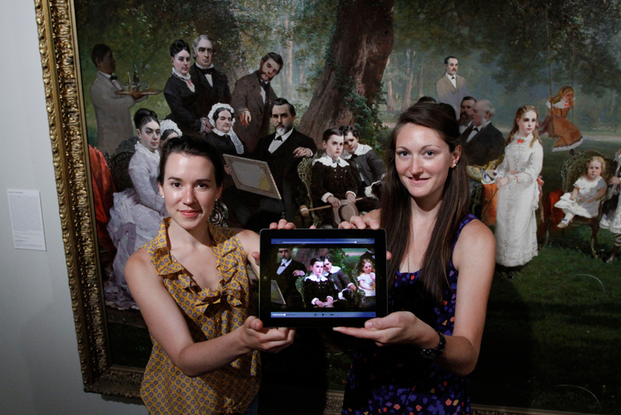
The Cantor Arts Center earned a 2015 Gold Muse Award from the American Alliance of Museums’ Media and Technology Professional Network. The Cantor won the Honeysett and Din Award for TandemArt, a software application created by recent Stanford Graduate School of Education (GSE) students Renee Bruner and Meredith Downing. The app was designed to engage early learners (ages 3–6) and their parents and caregivers with art on view from the Cantor’s collection.
Bruner and Downing, both of whom earned master’s degrees in 2014, drew on what they had learned in the GSE’s Learning, Design and Technology program as well as their previous work experience: Downing had taught preschool at the Smithsonian Early Enrichment Center in Washington, D.C., and Bruner coded children’s e-books for Simon & Schuster. They created TandemArt, optimized for iPad but accessible from any tablet or mobile device, as their master’s thesis. During the year that they developed, revised and tested the app, they worked in partnership with the Cantor’s Family Programs Coordinator Lauren Hahn.
“We are delighted that Renee and Meredith’s love of museums drew them to the Cantor and thrilled that they are being rewarded for their innovative and important work to engage young audiences in the excitement of art and museums,” said Cantor Arts Center Director CONNIE WOLF. “Our mission is to connect with the academic life of the university, and we are deeply committed to academic accessibility. Renee and Meredith’s project, designed to foster connections with art for very young guests, aligns perfectly with the museum’s goals. The Cantor has always fostered a sense of discovery through direct experiences with works of art for all our visitors.”
The TandemArt app uses the history of the Stanford family to create a narrative around Leland Jr.’s 10th birthday party as depicted in Thomas Hill’s painting Palo Alto Spring. The app leads visitors on an adventure in the Cantor’s Robert Mondavi Family Gallery for 19th-century American and European art.
“Our goal was both to engage the youngest audiences in developmentally appropriate activities around the art, while also providing a tool for parents to better facilitate that experience,” Downing said. Bruner and Downing tested their digital prototype with a father and son, who at one point put the iPad down while continuing to engage with the art for 10 minutes. “That was when we knew we had accomplished our goal.” While TandemArt is specific to the Cantor Arts Center, Downing believes that many of the basic principles could be adapted to any museum space.
Muse Awards staff reported that “the jury loved how the experience targeted not only pre-literate children but also actively involves their caregivers in the experience. The idea of engaging young children in the delight of exploration of a museum’s exhibits and the exchange with others in TandemArt truly fosters the development of the next generation of museum visitors and supporters.”
Now in its 26th year, the Muse Award competition, an activity of the Media and Technology Professional Network of the American Alliance of Museums, recognizes outstanding achievement in museum media. The competition received more than 200 applications in 14 categories from a wide variety of museums in North America, Europe, Australia and Asia. This year’s entries included videos, interactive hand-held tours, applications, podcasts, blogs, online communities, Web sites, audio tours and gallery installations.
The Honeysett and Din Award recognizes top entries of student works that meet the criteria for any category.
___
This story was originally published in the Stanford Report Dish.
Subscribe to our monthly newsletter.